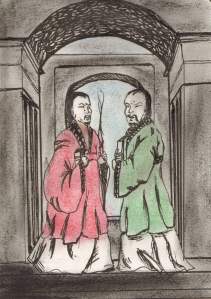by Rebecca McLean
University of Stirling
Read the chapter here. Listen to the chapter and investigate below:
In chapter seven, MacDonald develops the search for a cure to the Princess’s weightlessness. ‘Try Metaphysics’ is an intriguing chapter of ‘The Light Princess'(1864) because it shows the appeal to mainstream thought in the search for a cure as being detrimental to the Princess’s well being. Following the king’s rejection of an appeal to the court physicians in chapter five, ‘He would have consulted the court physicians; but he was afraid they would try experiments upon her,’ we are introduced to the court philosophers, Hum-Drum and Kopy-Keck. Their conversation is a realisation of the king’s fears.
The experiments mooted by the court philosophers display a lack of consideration for the individual experimented upon. The Princess becomes purely an object of the experiments of the court philosophers and is dehumanized in the pursuit of knowledge to allow the philosophers to do their ‘duty’. This level of violent medical intervention is, to the king and queen’s mind, tantamount to torture and the objectification of the Princess in pursuit of a conclusive proof of Hum-Drum’s theory is deeply sinister and contrasting with the approach of her parents who focus upon her individual experience of weightlessness. The absurd characterisation of Hum-Drum and Kopy-Keck, turn these sinister and dehumanising suggestions in to a humorous interlude of long-winded academic debate. The limits of accepted knowledge are reached and the Princess defies classification: ‘Indeed, the most complete knowledge of the laws of nature would have been unserviceable in her case; for it was impossible to classify her. She was a fifth imponderable body, sharing all the other properties of the ponderable.’ MacDonald has allowed the rejection of conventional medicine and the suggestion that the knowledge of the laws of nature is incomplete; this is a reflection of the thinking surrounding the rise of homeopathy during MacDonald’s lifetime. The Princess is not placed out into the natural world by the narrator; rather she becomes an as-yet undiscovered aspect of nature.

Chapter Seven, ‘Try Metaphysics’: ‘She does not belong by rights to this world at all, but to some other planet, probably Mercury. Her proclivity to her true sphere destroys all the natural influence which this orb would otherwise possess over her corporeal frame. She cares for nothing here. There is no relation between her and this world.’
In 1867, three years after the first publication of ‘The Light Princess’ in Adela Cathcart (1864), according to the the Homeopathic Medical Directory of that year, there were approximately sixty four homeopathic dispensaries in the UK, rising to one hundred and seventeen by 1874. Homeopathy’s rise in popularity caused a reduction in detrimental treatments such as blood letting, purging and the prescription of mercury (Ernst and Kaptchuk). The suggestions of Hum-Drum include blood-letting and asphyxia: the conventional nature of these cures is reflected in the philosopher’s name. Kopy-Keck’s theory is based upon the idea the the Princess should have been born on the planet Mercury which also resounds with the changes that the popularity of homeopathy brought about. The adoption of homeopathic medicine was prevalent among many of MacDonald’s contemporaries and friends. An 1895 address book of the homeopathic practitioner James Jon Garth Wilkinson contains many notable names including: Henry Wadsworth Longfellow, the Oliphant family, Dante Gabriel Rossetti, Alfred Lord Tennyson and George MacDonald. It is therefore unsurprising to discover that MacDonald’s writing contains aspects of homeopathic philosophy, most notably Gutta Percha Willie (1873), a realist children’s novel about the development of a homeopathic medical practitioner. ‘The Light Princess’ also uses aspects of homeopathy. The development of homeopathic thought begins in chapter seven of the tale, with the rejection of conventional medical practices.
The rejection of conventional medicine and suggestion of undiscovered aspects of nature in ‘The Light Princess’ is illustrative of MacDonald’s views regarding homeopathy. By questioning the benefits of science and experimentation MacDonald is also making a deeper point about the importance of caring for the individual. When the well-being of the person being treated is not central to the scientists’ thoughts the natural world is shown as the basis for individual healing and advancement. MacDonald’s own rejection of conventional medicine and his desire to respect the individual patient is reflected in the move beyond conventional solutions in ‘The Light Princess’. This chapter sets up the narrative towards an expectation of a natural cure being found for the Princess through the rejection of mainstream methods represented by Kopy-Keck and Hum-Drum’s proposed cures. At first glance the Princess appears to be left without hope of a cure at the end of the chapter, but by reading it as a reflection of MacDonald’s support for homeopathy the beginnings of a solution to the Princess’s malady can be seen. As chapter eight will show, there is a natural cure for the Princess’s weightlessness.
Works Cited
Ernst, Edzard and Ted J. Kaptchuk, ‘Homoeopathy Revisited’ Arch Intern Med. 1996; 156(19): pp. 2162- 2164.
Swedenborg Archive. ‘Address Book of James John Garth Wilkinson’ dated 1895.
MacDonald, George. Gutta Percha Willie. Whitethorn, Calif: Johannesen, 1993.
MacDonald, George. Adela Cathcart Whitethorn, Calif: Johannesen, 1994.

MacDonald seems continually concerned with the rejection of conventional, mass-prescribed social conventions in favor of something altogether more individual and case-specific. He is never one to totalize. As a unsuccessful-orthodox-pastor-turned-lecturer-and-writer (and whose stories are filled with subversive, “Bildungsromanesque” messages and characters), an interest in homeopathy, as opposed to mainstream medicine seems like a very characteristic choice. For me this aspect is particularly welcome in the fairy tale genre where the proscriptive impulse is so traditionally prevalent.
Pingback: ‘The Light Princess Suite’ No. 3: “The Princess” | Subverting Laughter:·